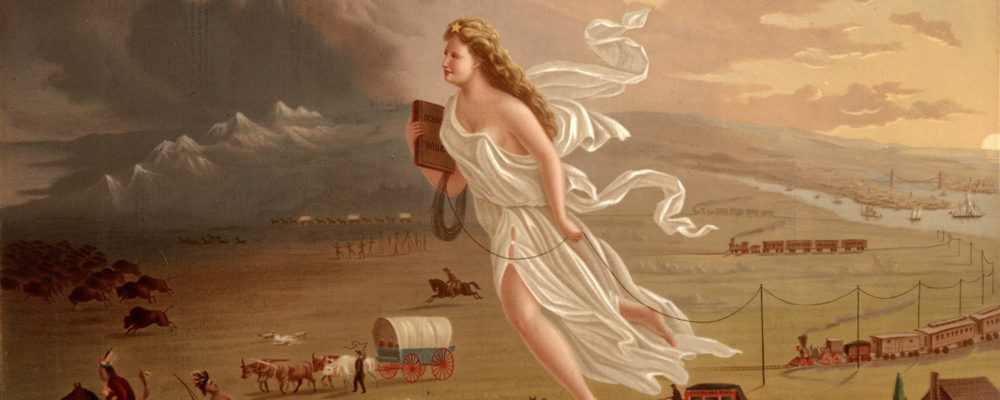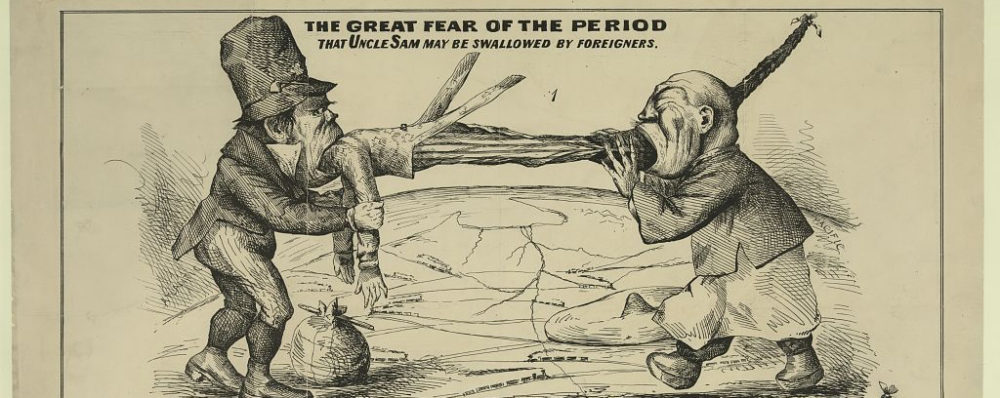
John Gast, American Progress, 1872. Wikimedia.
Introduction
Many Americans believed that the United States was destined to conquer the American continent and perhaps beyond. Other Americans protested these expansions as betrayals of American values. Debates over expansion, economics, diplomacy, and manifest destiny exposed some of the weaknesses of the American system. The chauvinism of policies like Native American removal, the Mexican War, and filibustering, existed alongside growing anxiety. Manifest destiny attempted to make a virtue of America’s lack of history and turn it into the very basis of nationhood. According to these Americans, the United States was the embodiment of the democratic ideal. Democracy had to be timeless, boundless, and portable. New methods of transportation and communication, the rapidity of the railroad and the telegraph, the rise of the international market economy, and the growth of the American frontier provided shared platforms to help Americans think across local identities and reaffirm a national character. These sources demonstrate the conflicts over antebellum American expansion.
Documents
Native Americans responded differently to the constant encroachments and attacks of American settlers. Some resisted violently. Others worked to adapt to American culture and defend themselves using particularly American weapons like lawsuits and petitions. The Cherokee did more to adapt than perhaps any other Native American group, creating a written constitution modeled off the American constitution and adopting American culture in dress, speech, religion and economic activity. In this document, Cherokee leaders protested the loss of their territory using a very American tactic: petitioning.
John Louis O’Sullivan, a popular editor and columnist, articulated the long-standing American belief in the God-given mission of the United States to lead the world in the transition to democracy. He called this America’s “manifest destiny.” This idea motivated wars of American expansion. He explained this idea in the following essay where he advocated adding Texas to the United States.
The experience of migrating west into territory still controlled by Native Americans was difficult and dangerous. In these diary excerpts we find the experience of Amelia Stewart Knight who traveled with her husband and seven children from Iowa to Oregon. She was pregnant the entire trip and gave birth to her eighth child on the side of the road near the journey’s end.
The California Gold Rush of 1849 brought a major influx of Asian immigrants to the new state. This number only grew after railroad companies turned to Chinese laborers to build western railroads. Life for these immigrants was particularly difficult, as even financially successful Chinese immigrants faced considerable discrimination. In 1860, the Chinese merchant Pun Chi drafted this petition to congress, calling on the legislature to do more to protect Chinese immigrants.
In 1843, the Wyandotte nation was forcefully removed from their homeland in Ohio and brought to the Kansas Territory. They found themselves on a borderland between Missouri’s slave society and land held by Native Americans. When the national Methodist church split, debates over slavery threatened the Christianity of the Wyandotte. This letter depicts the complex relationship between recently removed Native peoples, Christianity, and slavery.
During a trip to the United States, Venezuelan General Francisco de Miranda worked to launch a revolution in Venezuela that he expected would spread throughout South America. He made a series of high-level contacts, as indicated in the letters below. The American public saw South American revolutionaries as “fellow republicans.” At least three American ships, numerous American guns, and about 200 recruits participated in Miranda’s failed attempt at Revolution.
The spirit of Manifest Destiny had its corollary in an earlier piece of American foreign policy. Americans sought to remove colonizing Europeans from the western hemisphere. As Secretary of State for President James Monroe, John Quincy Adams crafted what came to be called the Monroe Doctrine. President Monroe outlined the principles of this policy in his seventh annual message to Congress, excerpted here.
Media

John Gast, American Progress, 1872. Wikimedia.
Columbia, the female figure of America, leads Americans into the West and into the future by carrying the values of republicanism (as seen through her Roman garb) and progress (shown through the inclusion of technological innovations like the telegraph) and clearing native peoples and animals, seen being pushed into the darkness.

“The great fear of the period That Uncle Sam may be swallowed by foreigners : The problem solved,” 1860-1869, Library of Congress.
Many white Americans responded to increasing numbers of immigrants in the 1800s with great fear and xenophobic hatred, seeing immigrants as threats to their vision of manifest destiny. This cartoon depicts a highly racialized image of a Chinese immigrant and Irish immigrant “swallowing” the United States–in the form of Uncle Sam. In the second image, the Chinese immigrant swallows the Irish immigrant. Networks of railroads and the promise of American expansion can be seen in the background.


